
Andrea Beck
Profile by Dave Jenkinson.
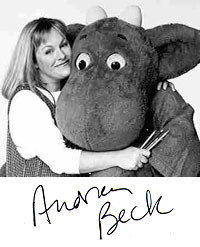 Although Andrea Beck, creator of the "Elliot Moose" series, was born in Montreal, PQ, on October 25, 1956, she actually grew up outside of Montreal in an English community called Rosemere, a little town of 3000 people. "I stayed there until I was 11. When I'm speaking to school groups, the children want to know where story ideas come from. We have a chat about imagination and how playing pretend is actually about making stories in your head. I tell them about how where I grew up, there were no children my age, and so I didn't have human friends. I had toy friends. I guess that's why it's easy for me to think of toys as alive. I have two sisters, but they were both older and weren't interested in playing with a little tag-along. My toys were my playmates."
Although Andrea Beck, creator of the "Elliot Moose" series, was born in Montreal, PQ, on October 25, 1956, she actually grew up outside of Montreal in an English community called Rosemere, a little town of 3000 people. "I stayed there until I was 11. When I'm speaking to school groups, the children want to know where story ideas come from. We have a chat about imagination and how playing pretend is actually about making stories in your head. I tell them about how where I grew up, there were no children my age, and so I didn't have human friends. I had toy friends. I guess that's why it's easy for me to think of toys as alive. I have two sisters, but they were both older and weren't interested in playing with a little tag-along. My toys were my playmates."
"I wanted to be a ballerina," recalls Andrea. "I really loved to dance and would leap around the living room a lot. Then I wanted to be a vet. My mother always called me her 'little artist,' but after about age five, I stopped making pictures at home, for many reasons. In grade 11, I took a couple of art courses. One of them was half an hour twice a week taught by a young woman, Mrs. Langford, who was a truly inspiring teacher. I think that she had studied fine arts herself, and she was able to reconnect me with the whole idea of drawing and painting. I got very excited by her class and decided 'Yes, I would try and go to art school.'"
The art program Andrea attended was at Dawson College, a Montreal CEGEP. "It was my first experience with having to present a portfolio, and it was very scary. I was 16, and I had just thrown together as many things as I could possibly create, and they hardly looked at it. They just kind of flipped through it and said, 'OK, you're in.' I was so surprised. At Dawson, I learned to paint from Jerry Roach. He was my biggest influence. Dawson was a fantastic opportunity. It was a total immersion in painting, drawing, sculpture, colour, history, print making, all of the essentials that you need if you're going to be any kind of artist at all. It was a two year program, and after that I took some time off. Then I attended Ontario College of Art and Design where I studied design."
Entrance to OCAD also called for Andrea to present her portfolio, and she recalls the experience.
"I came with my now established portfolio of things that I had created at Dawson College and on my own, realistic oil paintings and the like. The person who interviewed me said, 'So, you want to go into illustration.' It was more a statement than a question, not, 'Don't you think you should go into illustration?' Of course, I had come fresh from this ivory tower where illustration was a lower art, not 'fine' art, and I was rather insulted actually. "Illustration? No, I'm not here for illustration!" And, here it is, 25 years later, and what am I doing? He called it. He could see. Although I still think of getting back to 'real' painting one day."
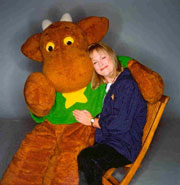
Attending OCAD led to Andrea's establishing her own toy company. "I never consciously set out to be a plush designer, but a toy company approached our multi-media print class to design a toy. When this little extra assignment came in, it piqued my interest, but what bothered me a little, back in my days of believing in 'justice,' was that 32 of us bright minds were each designing a toy. Yet one person would be awarded a prize of $200, so 32 designs would have cost the company only $200. I thought, 'Hmm, how efficient for them.' I also thought, 'I don't know if I want to give them my design to exploit because I might want to do something with it. And so I didn't give it to them."
"In the end, I took two designs I had created for the contest and that was the beginning of my toy company which I founded after I graduated and ran for the next five years. Before I sold it, there were 12 of us, including myself, but many of them were part-time 'cottage workers.' We wholesaled toys across Canada and some into the U.S. as well. We had a line of different kinds of moose, beavers, Teddy bears and rabbits. It's mostly Canadiana, and I sold them to places like Banff, Capilino Village in Vancouver, the Toronto Eaton Center, all the places with tourists who wanted to take home a moose or beaver."
"The toy company was a nice way to make a living, but from an art perspective, it was not very fulfilling. Then my children came along, and I was one of those mothers who found that it really pulled at my heartstrings to leave them every day. I thought, 'It was easy for me to start this business, and I built it into something successful.' I figured that I'd be able to do it again if it meant that much to me, but that I wouldn't be able to get the years back with my kids. I sold the company in 1986."
Being a mother provided the impetus for Andrea to complete a BA Hons. in Psychology from York University in 1996. "I have two budding filmmakers, ready to fly away. But when they were small that meant two highly creative children with unique perspectives and learning styles, and the first school years were difficult. I was getting so many different stories that I just wanted to delve into it further and deeper myself. To me, the logical place to start seemed to be the university. I ended up taking psychology and actually became more interested in other areas of psychology than educational psychology. However, my formal studies gave me the tools to analyze the information I was getting in a more critical way."
"After getting my honours degree, I attended two weeks of teachers college and realized that I would not be happy working in the Ontario school system as a primary teacher. When I was doing my placement in school, I was in a fairly large grade four class and a good third of the class needed extra help, and five of those needed a lot of help. They were kids with identified problems. I knew if I were the teacher in that class and had all of those kids depending on me, not getting to all of them (because the teacher I was with was not even close to getting to them), would have been really difficult for me. In the back of my mind, I knew that I could reach children another way."
It was at the age of 34 that Andrea began to get into writing. "I was writing stories, and the beginnings of Elliot was one of them. It was the one that stirred me the most. Later on, I took the kernel and turned it into Elliot." The impetus for starting to write, Andrea explains "was reading to my children. The books enchanted me. As a child growing up, we did not have a lot of books. I don't recall having picture books in our house although we may well have. I used to get my reading material at my grandmother's, snitching her Reader's Digest condensed books. I recall being intimidated by the library. It seemed unfamiliar, and so I guess I wasn't in one very often. Reading to my children was when I truly discovered picture books. And I thought, 'Oh, I'd love to do this.'"
"Tracing it back to when I had the toy company, I used to imagine that the toys were moving and mumbling amongst themselves, that they were alive. I used to often think that I'd like to write stories about them. But I didn't have a clue how to go about creating books, and I was in the business of making toys without a second to spare. So the roots of the writing go back to the toy company, and back further, to my childhood."
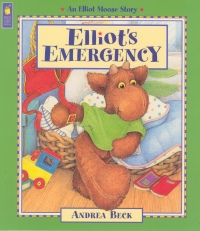
"Elliot was my very first submission ever, and it is unusual to have a first submission accepted. I spent a couple of years feeling that 'guilt' thing because I knew how other people tried so hard and submitted so many times without being published, my sister being one, and so it was very close to home. Actually I did a multiple submission, and I identified it as such. I sent it out by courier on a Thursday, and I heard from Kids Can Press the next morning at 9:30. I was shocked. I had just left teacher's college and was burnt out from going to school and doing two jobs, the second being an art club for children. My thinking had been, 'Well, I'll submit now because it will take six months for anyone to look at it anyway' because this is what I had been told by other writers. So I was shocked when KCP called and I was absolutely thrilled. Valerie Hussey's words were, 'Don't sign anything.' I heard from Stoddart during the next week, and so the submission was well received. From that very first phone call, Valerie expressed strong interest in publishing Elliot as a series. Of course, she needed to consult her people, and the following week she made the offer to produce it as a series."
What Andrea had submitted to the publishers was "a little mockup book, just black and white, very small. I put together what I thought was the best representation of what I wanted to accomplish with Elliot. At that point, I had done a little bit of commercial art but had never worked with an art director. So I was raw as an illustrator, but I did put a little note on the dummy saying that I thought I could do it and would like to do the pictures if they would consider me as the illustrator. And Kids Can took me on as both."
"With a series, you have to please many masters. The marketing, editorial, sales and rights departments all have something to say, along with a raft of other people who are asked for their comments. And you have to be careful not to step on the toes of other in-house series, in this case, "Franklin." It can become quite frustrating for the author because there are so many opinions flying around about everything. The story can become lost under the weight of everyone else's needs, expectations and taste. For instance, when creating the characters, I would have liked to include a mother figure for Elliot and his friends but was vetoed because there were parents in Franklin's world. At the beginning, I didn't fully understand the roles of the author and publisher, and people at KCP were very opinionated since it was their mission to teach me how to write, and I was open about wanting to learn. I still value their opinions tremendously, but I now have more trust in my own voice."
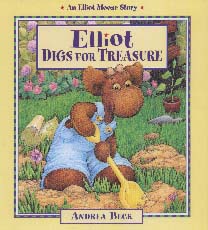
Asked why she elected to utilize stuffed animals as opposed to real animals, Andrea explained, "That, again, goes back to when I was a young child, and my toys were my friends. When I was about eight or nine-years-old, my mother threw all my animal toys away, every last one. I don't know why she did it, but one day I came home from school and they were all gone. I was devastated and yet kept it to myself. I don't think my mother ever understood that I was absolutely crushed. It was one of those pivotal events. Later on, well, the time came when I could tell the stories about characters that were too near my heart, and I knew that toys appeal to the child audience. I do have unpublished stories about live characters ... perhaps one day."
"Actually I first wrote about a live moose, but he never became truly alive in my head. Elliot assumed life after I saw him as a stuffed animal and I visualized him standing at the door, waiting. And he waited a long time. He waited all the way through my time at York University. What 'waiting' meant is that I would write on the very rare occasion that I was up at a friend's cottage or that sort of thing. But, after I identified him as a toy, all the other stories just melted away. Consequently, when I decided that teacher's college was not for me, I knew there was no question about what I was going to do. It was going to be Elliot. He'd been haunting me for five years. I got serious and began the mockup book the day after I left the program because I knew I couldn't be 80 years old and still have this little guy in my head, saying, 'How come you never let me out?' I wanted to share him."
A moose in the wild is certainly not the most handsome of animals, but Andrea defends her choice. "Take a look at Elliot. He's very sweet. One reason why I chose a moose might be that, of all the toys that we used to make in my studio, the moose were definitely the most interesting and best designed. They were funny, quirky, yet they stood on all fours. They were realistic looking. They were great toys. When I used to imagine the toys coming to life, it was always as I was passing six dozen huge moose on a table that I'd imagine that they were moving and mumbling amongst themselves. I found out that several of my ladies also were having the same fantasies. So it seemed to me that there was a place in the world for a little stuffed moose."
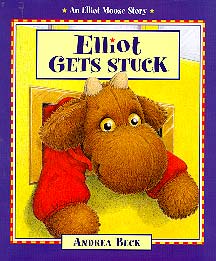
Despite Andrea's childhood connection with stuffed animals, none of her own childhood creatures appear in her books. "My favorite toy was a monkey, and, of course, Elliot's best friend is a monkey, but my monkey was very different. It had the plastic face and the banana that went in the mouth." Elliot's name, according to Andrea, "came from the ether. When I saw him standing there, his name was Elliot. He came to me complete that way, and his house came too. The original Elliot story, the one that I submitted, has never been published because it's the 'back' story that tells how Elliot came to life. Maybe one day if Elliot continues on and becomes a series with lots of books (which I hope it will), there will be a time and place to tell that story. When you're starting a series, if someone's read book number six, you don't want them picking up number one and getting disoriented because nobody knows each other, and so I had to let that story go. I was really quite attached to it."
"I had to establish exactly how Elliot's world was going to work. Did that mean that there were people in the world and Elliot could move only when they were all asleep or away? That's quite the cliche, but it works. I decided, however, that there were going to be no people in Elliot's world. This way he's freer and able to do more things. It's as if you're saying, 'They're existing on another plane of existence.' Occasionally with the art and just to be a bit scampy, I will insert things that show there has been a person floating through the house - like in the book Elliot's Christmas Surprise, I've added Christmas decorations on the mantlepiece. That will catch some child's eye and imagination."
"Elliot's Emergency was the very first book that I wrote or illustrated, and there were decisions that I made because I was inexperienced. I've decided that I'm not going to penalize the entire series for early lack of expertise. So, it's like Arthur's nose in Mark Brown's "Arthur" books. Arthur's nose, if you've ever seen the first story, was a very long nose, and yet Arthur has evolved to a round little face. There are similar issues in Elliot's Emergency. I let myself shift things around a little and change colors slightly and that sort of thing because I've decided I want the books to be excellent. And if it means a little inconsistency with the early books, I can live with that. With upcoming books, I really want to show more of the layout of the house. I thought that it was time because we've been seeing a lot of Elliot's room and the hall."
Pencil crayon was the medium Andrea elected to use for Elliot because "I felt pencil crayon suited these characters. It was not a medium that I was accustomed to using, and so I learned the media doing Elliot's Emergency, the first book. Now with Elliot's Noisy Night, which is book number seven, I am much more comfortable and the art is stronger. The Elliot style is heavily layered. A single page illustration takes about three and a half days, and then I'll often go back and fiddle with it for longer. The pictures have evolved to include a lot of detail because I think Elliot's world requires that. It's not that I love detailed art. In fact, quite the opposite is true. My favorite art is quite spare, but I think children reading about Elliot and all of his friends like that comforting, slightly cluttered, cosy world. If you'll notice with each book, they're becoming fuller. I'm putting more things in the illustrations. More clutter, more toys, more blankies, different wardrobe items. The world is evolving to a warmer place."

"When I'm creating the preliminary story board, I try and vary the perspectives, the points of view. Sometimes, something like a bird's eye view will work, and other times it won't. Sometimes it will require that the child really interpret what's going on, and some kids just figuring it out. For instance, in Elliot's Shipwreck, there's a view looking straight down on him in his raft. If I were a child looking at that, I would find it intriguing to see how he looked from that angle. That perspective's for when the children go back and are 'reading' the book for the third time. They know the story, but they are having more fun leisurely making their way through the pictures. There's a picture in Elliot Gets Stuck where Elliot is looking up at the door handle. It's a huge door confronting this little guy looking up. In an instance like that, I wanted the door to seem like this obstacle that this small, not terribly physical guy is going to have to sort out in order to get outside, and so the door almost has a personality of its own in a picture like that."
One of the recurring characters in the "Elliot" books is Beaverton, but, as previously noted, he was not Andrea's childhood stuffed toy. "Beavers were quite prominent in my company toy line as well, and I just love them. In the original story, Elliot's best friend was a beaver, but it was just too Canadian for the publisher. Kids Can wanted Elliot to be an international series, and so the beaver had to go. While the beaver got kicked out of the spotlight, I wouldn't let him go completely. Beaverton asks the right questions, and he knows how to do things. Like a beaver, he's the busy little engineer always making things."

Readers of the Elliot series may have noticed that Socks undergoes a color transformation. "Elliot was picked up for television early on but wasn't broadcast until we had completed three books. I was just beginning the art for the fourth book, Elliot's Bath, when the TV show began to air, and I needed to specify the colours for the Elliot merchandise. Sock's original color hadn't worked well under studio lights and so they changed her. I had to decide whether to make the books consistent with the TV, and that a decision to make, and that was a toughie because the television show was supposedly based on what I was doing. In the end, I decided that television would overrun Elliot anyway, and so I changed her colour to be more like the TV. I've actually made her a little more purple that she is on TV just because I really like purple."
"I tried Elliot as a girl at one point. It was at a time when I was learning about children's media at York. I had taken a course in media and children and the subversion of children, and I felt, 'Oh how irresponsible. I'm bringing in yet another male main character.' But Elliot didn't work as a girl because those little antlers are just so much a part of the visuals and a girl moose doesn't have them. So Socks, a girl, is his spunky best friend."
As noted, Elliot has appeared on television, first in 20 minute shows, and later in five minute episodes via Nelvana, TVO and YTV. Andrea played a role in the episodes' creation. "I was a creative consultant. There was a team of writers working under a head writer-editor at Nelvana, and they would pass all of the stories by me, and several other people, for comments. There was a time constraint -- they needed 104 stories in something like six weeks. That kind of pressure made everything very rushed. Unless something really jumped out at me, like something about the integrity of the story or the characters or some behavioral issue that I didn't want to model for children, I tended to be fairly quiet. There were certain things with the visuals that I was involve with, like the animation boards. I was consulted on the costumes, commented on the storyboards and all the stories -- things like that, but some things got lost in the rush, like Elliot's tail. My vision of Elliot's world is quieter and less slapstick than Nelvana's. The show is a meld of Elliot's Emergency and the vision of the team at Nelvana."
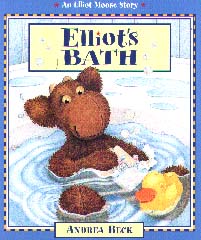
When it comes to writing, Andrea says, "I do have ideas on the go all the time, and often those ideas are triggered by an image. For instance, when I wrote Elliot's Bath, it was triggered by seeing him soggy in the tub and also by seeing him on the clothesline. I thought he would look adorable in both instances, and so I began to develop a story around what would happen if you gave a stiffed toy a bath. Sometimes I'll have an image, and there's no story ready yet. The story's still too deep down there to come out, but I'll store the image in my mental file."
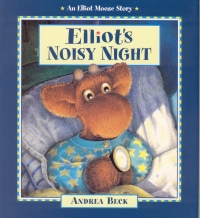
"Sometimes a story will be triggered by an event that happened in my childhood. Those are the stronger stories because there's that emotional connection. In Elliot's Emergency, Elliot tears his leg on a nail, and, for the longest while, (and this shows you how deep the story goes), I thought that the idea was triggered by an incident that had happened to my son where he pulled down a cupboard full of drinking glasses on to himself. He stood up in the middle of this pile of broken glass with a terrible gash on his hand. He was bleeding profusely, and, seeing his blood come out, he looked at me and said, 'Mummy, am I going to die now?' And, of course, what does that do to you as a parent? It goes right to your core, and I thought that was where the story came from because Elliot looked down and he sees his white stuffing and imagines himself as an empty shell of fur. It was three years later that I was talking with someone about my childhood, and I looked down at my leg and realized, 'I have a six inch scar on my leg that happens to be exactly where Elliot has the cut on his leg.' That happened when I was two or two and a half years old, and I don't remember it. I got shivers the day I realized that Elliot's Emergency came from hat buried childhood experience. Elliot's Noisy Night is also based on fears I had as a child."
"I've become more and more structured in my work simply because Elliot was overrunning my life and I had no more life. Of course, the television is over with now, as is the merchandising which took huge amounts of time. Everything's calmed down, and I'm now just enjoying being an author/illustrator. I have a little time now to think about a few other ideas that I'd like o work on."
Despite being so busy with Elliot, Andrea has illustrated a book for another author, her eldest sister, Carolyn Beck. "She wrote this poem twelve years ago. It's actually quite scandalous and gory. The book won't be coming out until the fall of 2003. Kids Can delayed it because of September 11th. It's about a postman, who, in a little dog's dream, meets a rather dubious end. It's a very sensory book. There's a lot of evocative description. It's going to be a great book for 12-year-old boys and for reluctant readers. It's a picture book, but we've actually put a little warning on the cover because it would be scary for younger children. In spite of being scary and gory, it's a seriously funny book. Typically, when adults open it, you end up with three or four people cackling around the book in a huddle. That's what happened the day I presented it at Kids Can."
"The art in Carolyn's book is very different from Elliot art. We were actually going to do the book under pseudonyms because I was worried about Elliot being effected by this truly 'bloody' work. However, Valerie insisted that I use my real name. The medium is acrylic paint, heavily layered. It was another learning experience doing that book. It was challenging but also fun for me to do something other than Elliot."
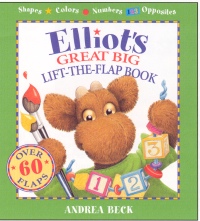
Forthcoming is Elliot's Great Big Lift the Flap Book. "It's a very large concept book with 60 flaps. It was a nightmare, yet fun to produce (if you can say that having just described it as a nightmare). Technically, it was a challenge because each spread needed four different layers. It's a story and a concept book, opposites, numbers, colours, and shapes. At Kids Can, when we had discussed 'alternate' Elliot books, I was taken by the idea immediately and started pushing for a 'lift the flap' out of all the options we were looking at. One nice thing about it is that it's allowed me to show another room in Elliot's house, the library, that could come into play quite a bit."
Asked if she sees herself as a writer who illustrates or an illustrator who writes, Andrea replied, "That's a difficult question to answer for me because I definitely live in my story world, and I think in terms of characters. The art, for me, is more of a chore, but it needs to be done to articulate the story visually. Yet, people just can't understand that because they look at me and see an artist. And yes, the words came after. I've just been writing for a few years, but that's where I get the pleasure. It's from the writing."
Books by Andrea Beck.
This article is based on an interview conducted in Winnipeg, MB, on September 8, 2002.
